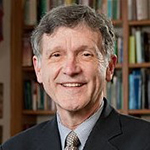 By Bill Leonard
By Bill Leonard
In scene one of Bertolt Brecht’s play Galileo, a boy named Andrea enters the scientist’s room carrying “a big astronomical model” showing earth at the center of the galaxy, an idea attributed to the ancient philosopher Ptolemy. Earth is thus surrounded by eight spheres that chart the sun and the planets as they revolve around the “fixed globe in the middle.” Galileo explains: “That’s the Earth. For two thousand years man has chosen to believe that the sun and all the host of stars revolve around him.” Andrea responds: “I can see with my own eyes that the sun comes up one place in the morning and goes down in a different place in the evening. It doesn’t stand still — I can see it move.” To which Galileo responds: “You see nothing, all you do is gawk. Gawking is not seeing.”
I’ve been studying Galileo Galilei (1564-1642) as part of a grant from the American Academy for the Advancement of Science, promoting science/religion studies in nine theological schools. My spouse, Dr. Candyce Leonard, a specialist in theatre studies, suggested that I ask my church history students to “read Galileo through Brecht.” The result was quite a learning experience for me, and I hope for students.
Born in Pisa, Italy, Galileo never married, but fathered three children. His two daughters became nuns, a protective option for females born of unmarried parents. Galileo’s correspondence with his daughter Virginia (Sister Maria Celeste) provides perhaps the most informative information of his personal and public life.
The greatest astronomer of his time, Galileo made extensive use of the newly invented telescope, discovering the existence of sunspots, moonscapes (mountains and valleys, not smooth as previously thought) and the role of the tides in charting Earth’s axis (he was right about tides, though wrong on details). These findings led to increased support for the heliocentric theory set forth in Copernicus’ work, On the Revolutions of the Heavenly Spheres, 1543. By 1616, Galileo was defending the Copernican assertion that the earth revolved around the sun, not vice versa. That same year the Inquisition condemned the theory as “foolish and absurd in philosophy, and formally heretical since it explicitly contradicts … the sense of Holy Scripture, according to the literal meaning of the words and according to the common interpretation and understanding of the Holy Fathers ….”
Catholic leaders viewed Galileo’s assertions as contradicting biblical texts including the day the sun “stood still” (Joshua 10:13) and 1 Chronicles 16:30, “the world cannot be moved.” Cardinal Robert Bellarmin ordered Galileo “to abandon completely” the view “that the sun stands still at the center of the world and the earth moves … or defend it in any way whatever, either orally or in writing.” Galileo acquiesced (reluctantly).
Brecht has an “Old Cardinal” declare, “I won’t have it! I won’t be a nobody on an inconsequential star briefly twirling hither and thither … the Earth is the center of all things, and I am the center of the Earth, and the eye of the Creator is upon me.”
Galileo slipped under the ecclesiastical radar until 1632 when he published Dialogue on the Great World Systems, Ptolemaic and Copernican, affirming heliocentricism. The new pope, Urban VIII, a humanist-oriented advocate of scientific pursuits, was taken by surprise, distressed that Galileo neglected to include a disclaimer that God can create in multiple ways, all beyond human perception. Called to Rome, Galileo confronted the Inquisitors, who warned that failure to recant could have dire consequences. One Inquisitor noted, “He was told to tell the truth, otherwise one would have recourse to torture.” Brecht’s Galileo comments: “I cannot afford to be smoked on a wood fire like a ham.”
Thus he confessed (1633): “After having been admonished by this Holy Office entirely to abandon the false opinions that the Sun is the center of the world and immovable, and that the Earth is not the center of the same and that it moves, and that I must not … defend, nor teach in any manner whatever, either orally or in writing, the said false doctrine, and after it has been notified to me that the said doctrine was contrary to Holy Writ …, I abjure with a sincere heart and unfeigned faith, I curse and detest the said errors and heresies, and generally all and every error and sect contrary to the Holy Catholic Church.” House arrest followed.
Brecht read church and scientist through his own times. The first anti-Nazi version posits Galileo rather heroically, standing for liberty against a fascist Church. He warns: “Take care when you travel through Germany with the truth under your coat.” A second version, written after Hiroshima, focuses on a-less-heroic Galileo whose discoveries mark a first step toward the atomic bomb!
We all read the past through spectacles of the present, “gawking” our way to truth through faulty dogmas, theorems, proof-texts and politics. Generations later, we finally “see,” recanting our recantations, and repenting of our forebears’ torturous Inquisitions. Brecht’s Galileo concludes:
May you now guard science’s light, Kindle it and use it right,
Lest it be a flame to fall, Downward to consume us all.
See?
